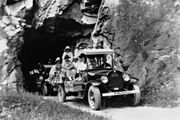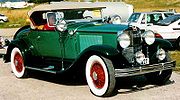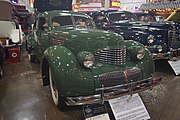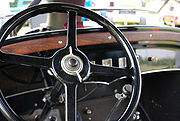Graham-Paige
Automobiles, trucks | |
| Founded | 1927 |
|---|---|
| Founders | Joseph B. Graham Robert C. Graham Ray A. Graham |
| Defunct | 1962 |
| Headquarters | , U.S. |

Graham-Paige was an American automobile manufacturer founded by brothers Joseph B. Graham (1882-1970), Robert C. Graham (1885-1967), and Ray A. Graham (1887-1932) in 1927. Automobile production ceased in 1940, and its automotive assets were acquired by Kaiser-Frazer in 1947. As a corporate entity, the Graham-Paige name continued until 1962.[1]
History

Graham Brothers
After successful involvement in a glass manufacturing company (eventually sold to
Graham's new truck line for 1928 included four 4-cylinder models ranging from 1⁄2 to 1+1⁄2 short tons (450 to 1,360 kg) and one 2-short-ton (1,800 kg) 6-cylinder model, which used the same engine as the Dodge Brothers Senior Six, lightly modified for truck duty.

Graham-Paige

In 1927, with the banking syndicate controlling Dodge trying to sell the company, the Graham brothers decided to enter the automobile business on their own. In 1927, they purchased the Paige-Detroit Motor Car Company, makers of Paige and Jewett automobiles, for $3.5 million ($61,390,805 in 2023 dollars [3]).[1] Joseph became president, Robert vice-president, and Ray secretary-treasurer of the company.[1] The company's initial offerings included a line of Graham-Paige cars with 6 and 8-cylinder engines. For a while, a line of light trucks was offered under the Paige name, soon discontinued when Dodge reminded the Grahams about the non-competition agreement they had signed as part of the sale of the Graham Brothers Company. Graham earned a reputation for quality and sales quickly rose. Graham also had some success in racing, which helped boost sales. The Graham company logo included profiles of the three brothers and was used in insignia on the cars including badges and taillight lens.[1]
Graham-Paige made most of their own bodies and engines. The Graham brothers had solved a long-standing Paige body supply dilemma by purchasing the Wayne Body Company in Wayne, Michigan, and expanding the factory along with other body plants.[1] They did not have a foundry and contracted with Continental for these services relative to their engines.[1] Some models did use Continental stock engines. Graham-Paige's own engineering department designed most of the engines used in Graham-Paige cars. The 1938–1940 "Spirit of Motion" cars and Hollywood models are frequently incorrectly stated to use Continental engines. After World War II, Continental produced a lesser version of Graham-Paige's 217-cubic-inch-displacement engine used in the previously mentioned models. These engines were used in the post-war Kaiser and Frazer automobiles.
Initially, Graham-Paige withstood the onset of the
For engineering, the rear kickup on the chassis frame was eliminated by the adoption of a 'banjo' frame.[1] Unlike contemporary practice, the rear axle was placed through large openings on both sides of the frame, with rubber snubbers to absorb any shock if the car axle should make contact. This in turn permitted a wider body. To help lower the car, the rear springs were mounted on the outer sides of the chassis frame and not under the frame. This idea was eventually copied by other manufacturers - Chrysler, for example, in 1957.
For 1934, Graham introduced a crankshaft-driven supercharger, designed in-house by Graham Assistant Chief Engineer Floyd F. Kishline.[4] At first offered only in the top 8-cylinder models, the supercharger was adapted to the six in 1936 when the eights were dropped. Through the years, Graham would produce more supercharged cars than any other automobile manufacturer until Buick surpassed them in the 1990s.
By 1935, the "Blue Streak" styling was getting rather dated. A restyling of the front and rear ends for 1935 proved to be a disaster, making the cars appear higher and narrower.[1] Having no money for a new body, Graham signed an agreement with REO Motor Car Company to purchase car bodies, paying them $7.50 ($156 in 2023 dollars [3]) in royalties for each Hayes-built body.[1] The engines did have new full water jackets.[5] Graham added new front end styling and revised detailing to these bodies to create the 1936 and 1937 Grahams.
Amos Northup of Murray Body was hired to design a new model for 1938, but he died before the design was complete.[1] It is believed the final design was completed by Graham engineers.[6] The new 1938 Graham was introduced with the slogan "Spirit of Motion".[1] The fenders, wheel openings and grille all appeared to be moving forward. The design was widely praised in the American press and by American designers. It also won the prestigious Concours D'Elegance in Paris, France.[7] Wins were also recorded in the Prix d'Avant-Garde at Lyon, the Prix d'Elegance at Bordeaux, and the Grand Prix d'Honneur at Deauville, France.[8] Its cut-back grille later gained the car the name "Sharknose", which appears to have origins in the 1950s. The styling was a complete flop in sales.[9] The most reliable estimates, from period publications, suggest the total production of all three years of these cars is between 6,000 and 13,000 units. With this low production Graham limped through 1939 and 1940.
Joint venture
Desperate for a winning offering and unable to retool, Graham made a deal with the ailing Hupp Motor Co. in late 1939. According to the deal, the faltering company entered into an arrangement with
Graham agreed to build the Hupmobile Skylark on a contract basis, while receiving the rights to use the distinctive Cord dies to produce a similar car of its own, to be called the Hollywood.[1] The striking Skylark/Hollywood differed from the Cord from the cowl forward with a redesigned hood, front fenders and conventional headlights, achieved by automotive designer John Tjaarda of Lincoln-Zephyr fame. The Cord's longer hood was not needed, as the Hupp and Graham versions were rear-wheel drive. This also necessitated modifying the floor to accept a driveshaft. Graham chose the four-door Beverly sedan shape for the Hollywood rather than the two-door convertible, as they wanted the Hollywood to be a popular, mass-market car.[11]

Both versions used 6-cylinder engines. The Skylark was powered by a 245 cu in (4,010 cc) Hupp; the Hollywood was available with a standard 218 cu in (3,570 cc)[10] and an optional supercharged version,[1] both manufactured by Graham-Paige. While some 1500 Hollywoods were built,[10] it did not stop the company's slide. After its public introduction, orders poured in. However, manufacturing difficulties caused months of delay before deliveries began. Having bodies ultimately built by the coachbuilder Hayes did not help.[10] Customers tired of waiting, and most of the orders were cancelled.[1] Despite an enthusiastic initial public response, the car actually ended up being a worse flop in the sales department for both Graham and Hupmobile than either firm's respective preceding models. The company suspended manufacturing in September 1940,[1] only to reopen its plant for military production for World War II.
Postwar
The company resumed automobile production in 1946 producing a modern-looking new car, the 1947 Frazer, named for new Graham-Paige president
Post-automotive legacy
In 1952, Graham-Paige dropped the "Motors" from its name and branched into real estate,
- Gallery
-
Graham Brothers truck
-
1929-30 Graham-Paige with early mobile camper trailer at Glacier National Park; December, 1933.
-
Graham-Paige Model 610 4-door Sedan 1928
-
Graham-Paige Model 827 Roadster 1929
-
Graham Paige 612 Tourer, 1929
-
A restored 1929 Graham-Paige Model 612
-
Graham Convertible Coupé 1930
-
Graham Model 80A Crusader 4-door Touring Sedan 1936
-
1937 Graham Cavalier
-
1932 Graham Bluestreak 4-door Sedan
-
1939 Graham Custom Model 97 Sedan
-
Advertisement for Graham Hollywood, 1940
-
1941 Graham Hollywood Sedan
-
Instrument panel of a Model 613
-
Steering column of a Model 613. One lever in the center controls the headlights, the other is the hand throttle.
-
Graham Model 97 Supercharger 4-door Sedan 1939 "Spirit of Motion", later nicknamed "Sharknose"
-
1940 was the last year for the "sharknosed" Graham (Model 107)
-
Graham 8 cyl. engine, top view dominated by centrifugal supercharger
-
Graham-Paige 619 (1929) - still driven on the road in Switzerland
-
Graham-Paige 619 (1929) - in Switzerland
-
Graham-Paige 619 (1929) - door lever
-
Graham-Paige 619 (1929) - crank handle to rise the windscreen
-
Graham-Paige 619 (1929) - windscreen can be opened upwards
-
Graham-Paige 619 (1929) - gauges and gear lever
-
Graham-Paige 619 (1929) - Interior
-
Graham-Paige 619 (1929) - 6 cylinder engine still running strong
See also
- List of defunct automobile manufacturers of the United States
- New York Auto Showin January 1928.
- Dodge Brothers Company
- Kaiser-Frazer
Footnotes
- ^ a b c d e f g h i j k l m n o p q r s t u v w x y Odin, L.C. A concise guide to Graham-Paige. Belvedere Publishing, 2016. ASIN: B01G8X5Z34.
- ^ Stromberg, Austin W., ed. (January 1928). "Graham Bros. Display 5 Sizes". Power Wagon. XL (277): 28.
- ^ a b c 1634–1699: McCusker, J. J. (1997). How Much Is That in Real Money? A Historical Price Index for Use as a Deflator of Money Values in the Economy of the United States: Addenda et Corrigenda (PDF). American Antiquarian Society. 1700–1799: McCusker, J. J. (1992). How Much Is That in Real Money? A Historical Price Index for Use as a Deflator of Money Values in the Economy of the United States (PDF). American Antiquarian Society. 1800–present: Federal Reserve Bank of Minneapolis. "Consumer Price Index (estimate) 1800–". Retrieved February 29, 2024.
- ^ Keller, 1988, p. 42.
- ^ "Esquire's 1935 Automobile Parade-03". Archived from the original on 2015-01-12. Retrieved 2015-01-12.
- ^ Keller, 1988, p. 101.
- ^ Ritzinger, André. "Graham Model 97 Supercharged". www.ritzsite.nl. Retrieved 10 July 2013.
- ^ Keller, 1988, p. 91.
- ^ Odin, L.C. World in Motion 1939, The whole of the year's automobile production. Belvedere Publishing, 2015. ASIN: B00ZLN91ZG.
- ^ a b c d Curbside Classic.com (retrieved 10 July 2018
- ISBN 1840136359.
- ^ New York Times: "Irving M. Felt, 84, Sports Impresario, Is Dead" By AGIS SALPUKAS September 24, 1994
References
Keller, ME (1988). The Graham Legacy: Graham-Paige to 1932. Turner Publishing Company.
External links
- Allpar.com: Graham Brothers Trucks and Graham-Paige Motors
- Graham Owners Club International
- "1929 New Zealand advertisement for Graham Paige". Papers Past. 14 October 1929.


























